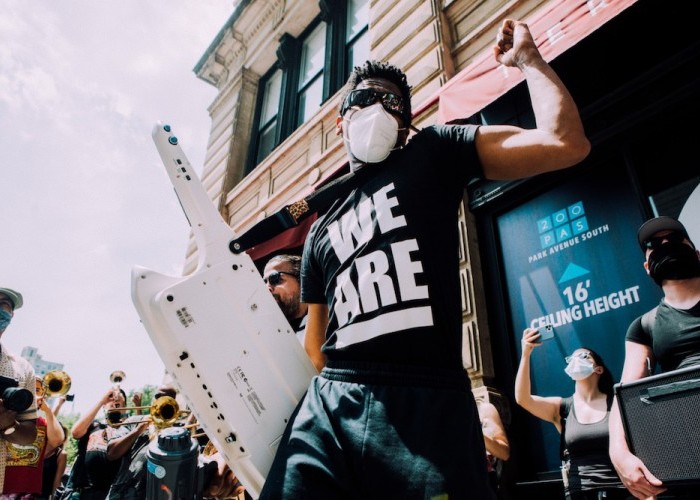Oct 28, 2025 10:47 AM
In Memoriam: Jack DeJohnette, 1942–2025
Jack DeJohnette, a bold and resourceful drummer and NEA Jazz Master who forged a unique vocabulary on the kit over his…

Multi-instrumentalist Jon Batiste is facilitating a series of music-forward protests through his WE ARE organization.
(Photo: Bram VanderMark)“[That’s why To Pimp A Butterfly] is such a jazz-centered record. Robert Glasper and Terrace Martin said [Lamar] thinks about music in that way. He’s presenting a different form of jazz to a younger generation. So, maybe they’re listening to jazz, and they just don’t know it, because it’s packaged in such a different and abstract way that it doesn’t hit them until later.”
To the 39-year-old Moore, the music isn’t just compelling, it’s politically relevant and speaks to the moment it was created: “Spiritual jazz and Black liberation jazz in 2015 coincided with the Black Lives Matter movement happening, which was [motivated in part by the deaths of] Eric Garner, Mike Brown, Sandra Bland and Freddie Gray.”
Just as protest and tumult are top of mind across the country, Moore sees the moment primed for jazz artists to continue speaking their truths.
“I feel like now is an opportunity for them to be the vanguard of this new movement,” Moore said, discussing recent recordings by Irreversible Entanglements and Shabaka and The Ancestors. “Obviously, that remains to be seen. For the Black Lives Matter movement, there’s always going to be a need for [music like that], because there’s always going to be a new hashtag, [a new] person who we’re going to mourn.”
PIANST JON BATISTE—a recording artist and the leader of Stay Human, the house band for The Late Show with Stephen Colbert—has begun work at creating one of those new movements with his WE ARE project.
“As a musician, I believe we’re ordained to change the course of history in relation to culture and politics through our art,” Batiste wrote in an email to DownBeat. “That is my activism.”
Batiste has made headlines for facilitating a series of music-forward protests as part of WE ARE, an organization he hopes can prompt direct political action and spur voters to cast ballots in the November election.
“There’s so much that jazz music does—it inspires change, tying people to the past while moving them into the future. Music is special in that way. It has always been something with multiple purposes in our life, including to heal our unspoken pain,” Batiste continued, circling back to the music’s ability to foster resilience. “The beautiful thing with music is that, as we’ve seen with the WE ARE protests and rallies, it creates an immediate bond. Now, more than ever, it’s important for us to use music in the ways our ancestors did—beyond entertainment—for what it is at its root, a vessel of hope.”
Even during what’s an undeniably troubling moment in history, most who took time to speak to DownBeat for this story still were able to summon at least a dash of the hope Batiste makes sure to mention.
Reed, who’s also the programming chair for the Chicago Jazz Festival, was planning to produce a series of streamed performances, some of which would serve as part of the fest’s programming during Labor Day weekend. But ahead of those sets, as he continued to prepare for music at his venues, Reed echoed a sentiment similar to Batiste’s.
“From my standpoint, jazz music is maybe the most possible idea in American culture [to bring] people together,” he said. “It’s not perfect, but it’s always had the ability to do that.” DB
This story originally was published in the October 2020 issue of DownBeat. Subscribe here.

Jack DeJohnette boasted a musical resume that was as long as it was fearsome.
Oct 28, 2025 10:47 AM
Jack DeJohnette, a bold and resourceful drummer and NEA Jazz Master who forged a unique vocabulary on the kit over his…

Goodwin was one of the most acclaimed, successful and influential jazz musicians of his generation.
Dec 9, 2025 12:28 PM
Gordon Goodwin, an award-winning saxophonist, pianist, bandleader, composer and arranger, died Dec. 8 in Los Angeles.…

Nov 13, 2025 10:00 AM
For results of DownBeat’s 90th Annual Readers Poll, complete with feature articles from our December 2025 issue,…

Flea has returned to his first instrument — the trumpet — and assembled a dream band of jazz musicians to record a new album.
Dec 2, 2025 2:01 AM
After a nearly five-decade career as one of his generation’s defining rock bassists, Flea has returned to his first…

To see the complete list of nominations for the 2026 Grammy Awards, go to grammy.com.
Nov 11, 2025 12:35 PM
The nominations for the 2026 Grammy Awards are in, with plenty to smile about for the worlds of jazz, blues and beyond.…








